An Analysis of Traditional Decision Making in Holiday Planning Essay
VerifiedAdded on 2020/02/03
|14
|4054
|146
Essay
AI Summary
This essay provides a comprehensive analysis of the traditional consumer decision-making process as it applies to holiday planning. It begins with an introduction that highlights the complexities of holiday decision-making, contrasting it with the more structured stages of consumer buying behavior. The essay then delves into the five crucial steps of the traditional decision-making process: need recognition, information search, evaluation of alternatives, purchase, and post-purchase evaluation. It examines how these steps are applied in the context of holiday planning, including the roles of internal and external information searches, the evaluation of various travel options, and the influence of reference groups such as family and friends. The essay also discusses the importance of information search and the impact of social media on consumer choices. The essay concludes by comparing the holiday decision-making process with that of purchasing household appliances, highlighting the unique factors that influence consumers in each scenario. Overall, the essay offers a detailed exploration of how consumers make decisions regarding holidays, providing insights into the motivations and influences behind their choices.
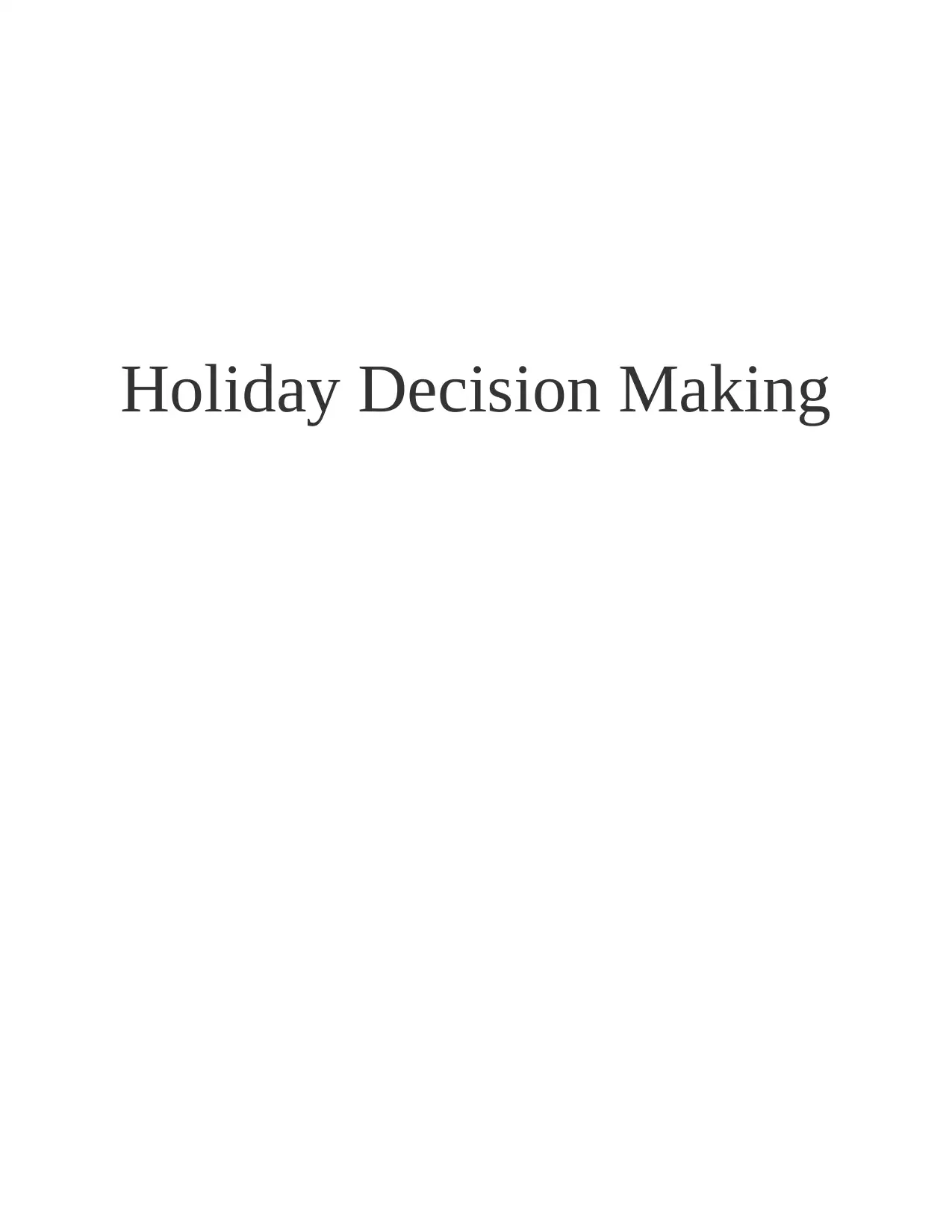
Holiday Decision Making
Paraphrase This Document
Need a fresh take? Get an instant paraphrase of this document with our AI Paraphraser
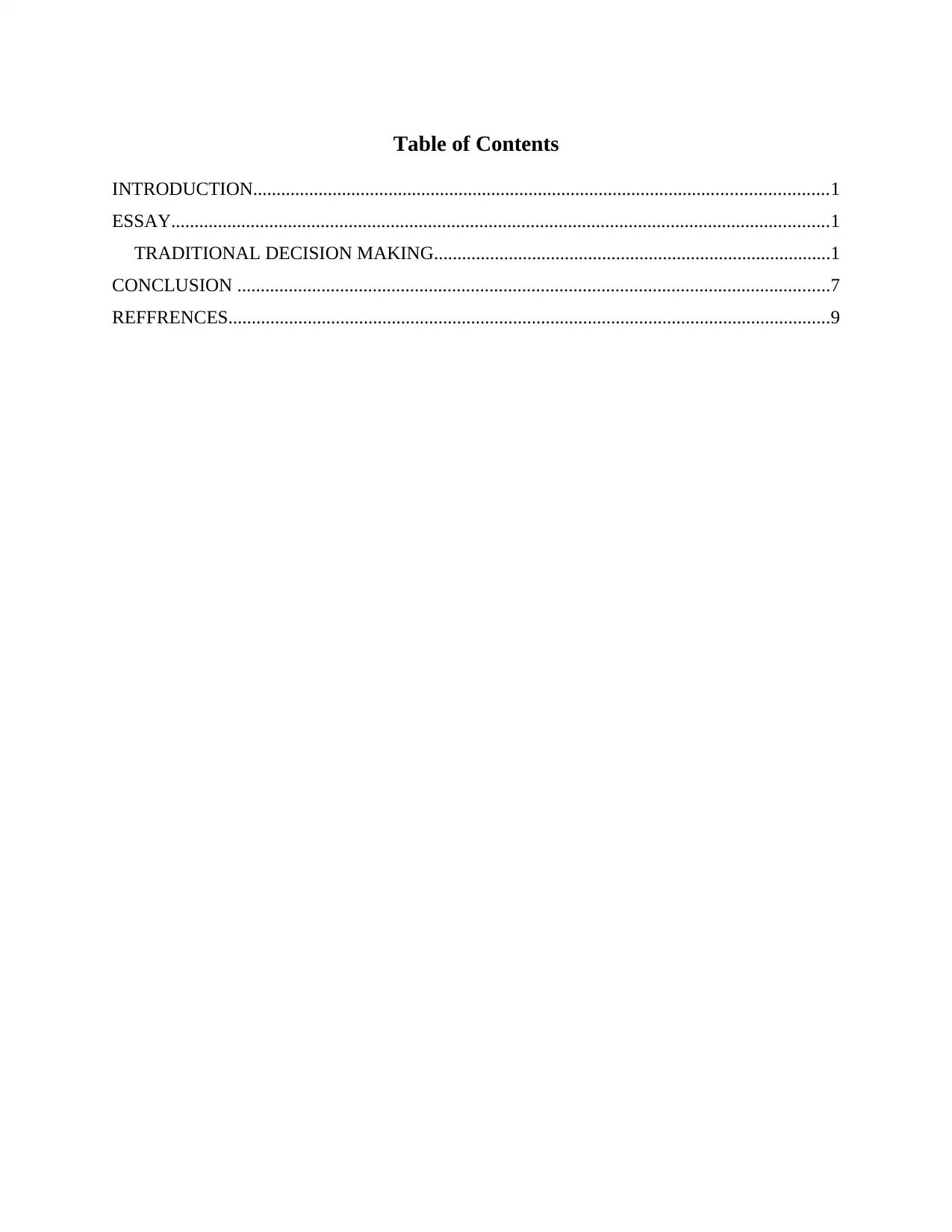
Table of Contents
INTRODUCTION...........................................................................................................................1
ESSAY.............................................................................................................................................1
TRADITIONAL DECISION MAKING.....................................................................................1
CONCLUSION ...............................................................................................................................7
REFFRENCES.................................................................................................................................9
INTRODUCTION...........................................................................................................................1
ESSAY.............................................................................................................................................1
TRADITIONAL DECISION MAKING.....................................................................................1
CONCLUSION ...............................................................................................................................7
REFFRENCES.................................................................................................................................9
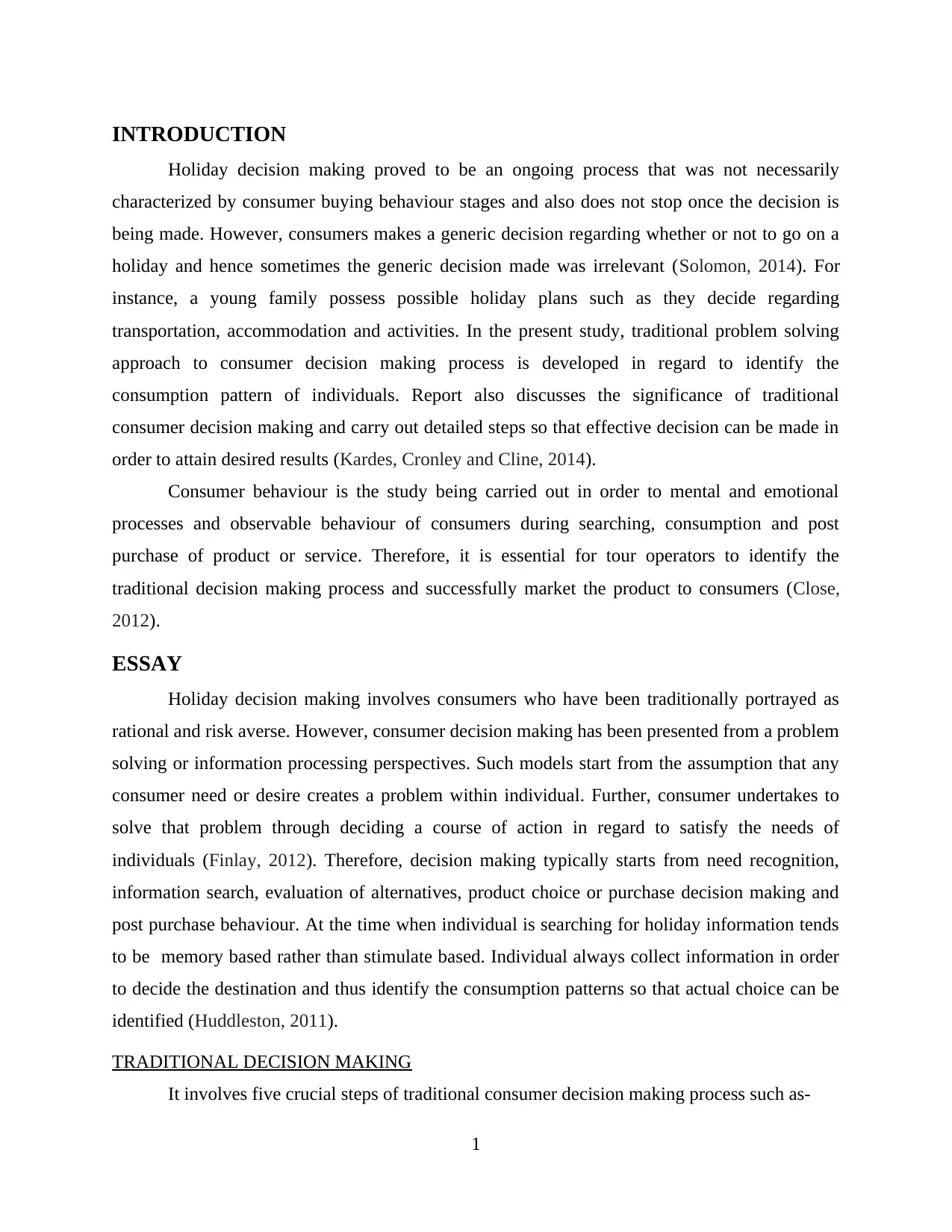
INTRODUCTION
Holiday decision making proved to be an ongoing process that was not necessarily
characterized by consumer buying behaviour stages and also does not stop once the decision is
being made. However, consumers makes a generic decision regarding whether or not to go on a
holiday and hence sometimes the generic decision made was irrelevant (Solomon, 2014). For
instance, a young family possess possible holiday plans such as they decide regarding
transportation, accommodation and activities. In the present study, traditional problem solving
approach to consumer decision making process is developed in regard to identify the
consumption pattern of individuals. Report also discusses the significance of traditional
consumer decision making and carry out detailed steps so that effective decision can be made in
order to attain desired results (Kardes, Cronley and Cline, 2014).
Consumer behaviour is the study being carried out in order to mental and emotional
processes and observable behaviour of consumers during searching, consumption and post
purchase of product or service. Therefore, it is essential for tour operators to identify the
traditional decision making process and successfully market the product to consumers (Close,
2012).
ESSAY
Holiday decision making involves consumers who have been traditionally portrayed as
rational and risk averse. However, consumer decision making has been presented from a problem
solving or information processing perspectives. Such models start from the assumption that any
consumer need or desire creates a problem within individual. Further, consumer undertakes to
solve that problem through deciding a course of action in regard to satisfy the needs of
individuals (Finlay, 2012). Therefore, decision making typically starts from need recognition,
information search, evaluation of alternatives, product choice or purchase decision making and
post purchase behaviour. At the time when individual is searching for holiday information tends
to be memory based rather than stimulate based. Individual always collect information in order
to decide the destination and thus identify the consumption patterns so that actual choice can be
identified (Huddleston, 2011).
TRADITIONAL DECISION MAKING
It involves five crucial steps of traditional consumer decision making process such as-
1
Holiday decision making proved to be an ongoing process that was not necessarily
characterized by consumer buying behaviour stages and also does not stop once the decision is
being made. However, consumers makes a generic decision regarding whether or not to go on a
holiday and hence sometimes the generic decision made was irrelevant (Solomon, 2014). For
instance, a young family possess possible holiday plans such as they decide regarding
transportation, accommodation and activities. In the present study, traditional problem solving
approach to consumer decision making process is developed in regard to identify the
consumption pattern of individuals. Report also discusses the significance of traditional
consumer decision making and carry out detailed steps so that effective decision can be made in
order to attain desired results (Kardes, Cronley and Cline, 2014).
Consumer behaviour is the study being carried out in order to mental and emotional
processes and observable behaviour of consumers during searching, consumption and post
purchase of product or service. Therefore, it is essential for tour operators to identify the
traditional decision making process and successfully market the product to consumers (Close,
2012).
ESSAY
Holiday decision making involves consumers who have been traditionally portrayed as
rational and risk averse. However, consumer decision making has been presented from a problem
solving or information processing perspectives. Such models start from the assumption that any
consumer need or desire creates a problem within individual. Further, consumer undertakes to
solve that problem through deciding a course of action in regard to satisfy the needs of
individuals (Finlay, 2012). Therefore, decision making typically starts from need recognition,
information search, evaluation of alternatives, product choice or purchase decision making and
post purchase behaviour. At the time when individual is searching for holiday information tends
to be memory based rather than stimulate based. Individual always collect information in order
to decide the destination and thus identify the consumption patterns so that actual choice can be
identified (Huddleston, 2011).
TRADITIONAL DECISION MAKING
It involves five crucial steps of traditional consumer decision making process such as-
1
⊘ This is a preview!⊘
Do you want full access?
Subscribe today to unlock all pages.

Trusted by 1+ million students worldwide
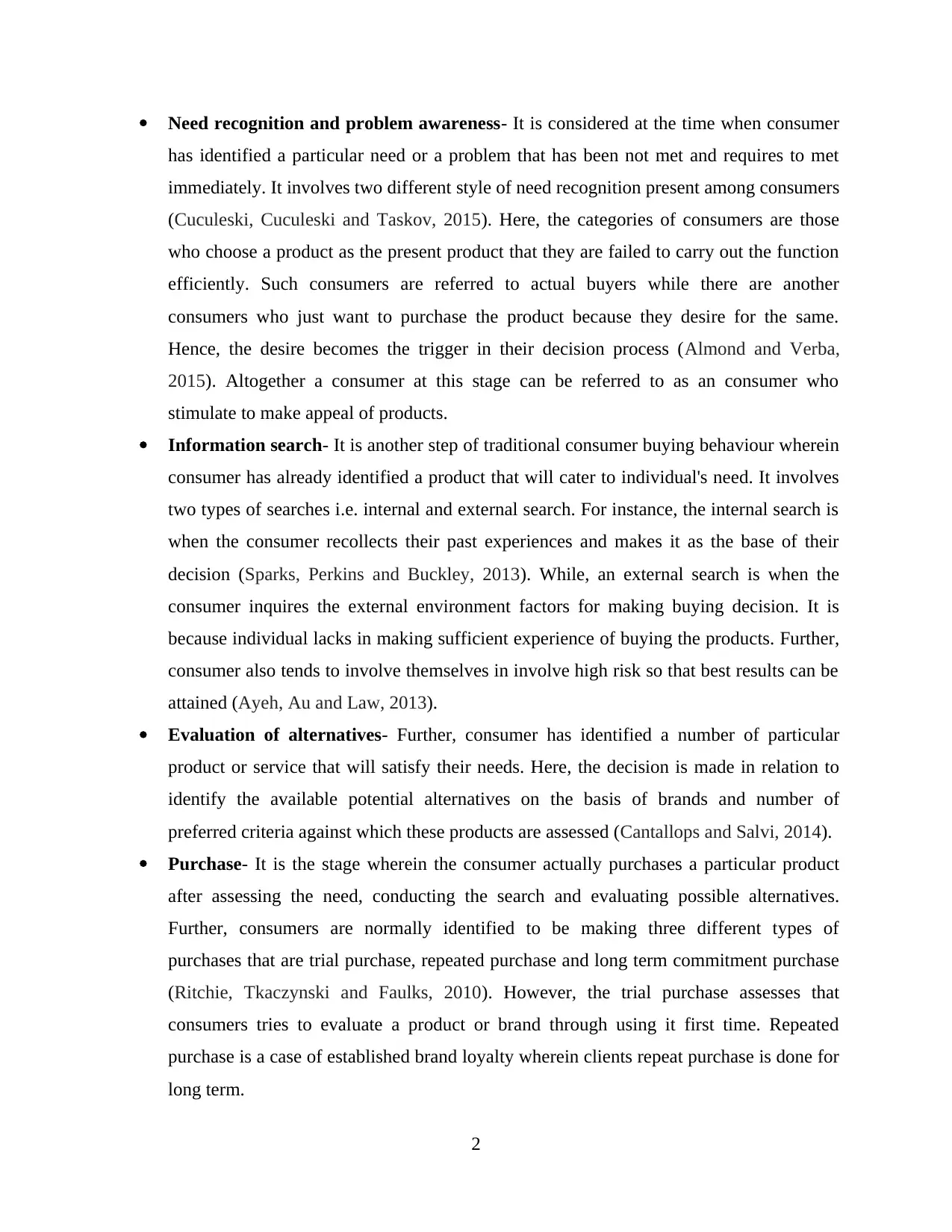
Need recognition and problem awareness- It is considered at the time when consumer
has identified a particular need or a problem that has been not met and requires to met
immediately. It involves two different style of need recognition present among consumers
(Cuculeski, Cuculeski and Taskov, 2015). Here, the categories of consumers are those
who choose a product as the present product that they are failed to carry out the function
efficiently. Such consumers are referred to actual buyers while there are another
consumers who just want to purchase the product because they desire for the same.
Hence, the desire becomes the trigger in their decision process (Almond and Verba,
2015). Altogether a consumer at this stage can be referred to as an consumer who
stimulate to make appeal of products.
Information search- It is another step of traditional consumer buying behaviour wherein
consumer has already identified a product that will cater to individual's need. It involves
two types of searches i.e. internal and external search. For instance, the internal search is
when the consumer recollects their past experiences and makes it as the base of their
decision (Sparks, Perkins and Buckley, 2013). While, an external search is when the
consumer inquires the external environment factors for making buying decision. It is
because individual lacks in making sufficient experience of buying the products. Further,
consumer also tends to involve themselves in involve high risk so that best results can be
attained (Ayeh, Au and Law, 2013).
Evaluation of alternatives- Further, consumer has identified a number of particular
product or service that will satisfy their needs. Here, the decision is made in relation to
identify the available potential alternatives on the basis of brands and number of
preferred criteria against which these products are assessed (Cantallops and Salvi, 2014).
Purchase- It is the stage wherein the consumer actually purchases a particular product
after assessing the need, conducting the search and evaluating possible alternatives.
Further, consumers are normally identified to be making three different types of
purchases that are trial purchase, repeated purchase and long term commitment purchase
(Ritchie, Tkaczynski and Faulks, 2010). However, the trial purchase assesses that
consumers tries to evaluate a product or brand through using it first time. Repeated
purchase is a case of established brand loyalty wherein clients repeat purchase is done for
long term.
2
has identified a particular need or a problem that has been not met and requires to met
immediately. It involves two different style of need recognition present among consumers
(Cuculeski, Cuculeski and Taskov, 2015). Here, the categories of consumers are those
who choose a product as the present product that they are failed to carry out the function
efficiently. Such consumers are referred to actual buyers while there are another
consumers who just want to purchase the product because they desire for the same.
Hence, the desire becomes the trigger in their decision process (Almond and Verba,
2015). Altogether a consumer at this stage can be referred to as an consumer who
stimulate to make appeal of products.
Information search- It is another step of traditional consumer buying behaviour wherein
consumer has already identified a product that will cater to individual's need. It involves
two types of searches i.e. internal and external search. For instance, the internal search is
when the consumer recollects their past experiences and makes it as the base of their
decision (Sparks, Perkins and Buckley, 2013). While, an external search is when the
consumer inquires the external environment factors for making buying decision. It is
because individual lacks in making sufficient experience of buying the products. Further,
consumer also tends to involve themselves in involve high risk so that best results can be
attained (Ayeh, Au and Law, 2013).
Evaluation of alternatives- Further, consumer has identified a number of particular
product or service that will satisfy their needs. Here, the decision is made in relation to
identify the available potential alternatives on the basis of brands and number of
preferred criteria against which these products are assessed (Cantallops and Salvi, 2014).
Purchase- It is the stage wherein the consumer actually purchases a particular product
after assessing the need, conducting the search and evaluating possible alternatives.
Further, consumers are normally identified to be making three different types of
purchases that are trial purchase, repeated purchase and long term commitment purchase
(Ritchie, Tkaczynski and Faulks, 2010). However, the trial purchase assesses that
consumers tries to evaluate a product or brand through using it first time. Repeated
purchase is a case of established brand loyalty wherein clients repeat purchase is done for
long term.
2
Paraphrase This Document
Need a fresh take? Get an instant paraphrase of this document with our AI Paraphraser
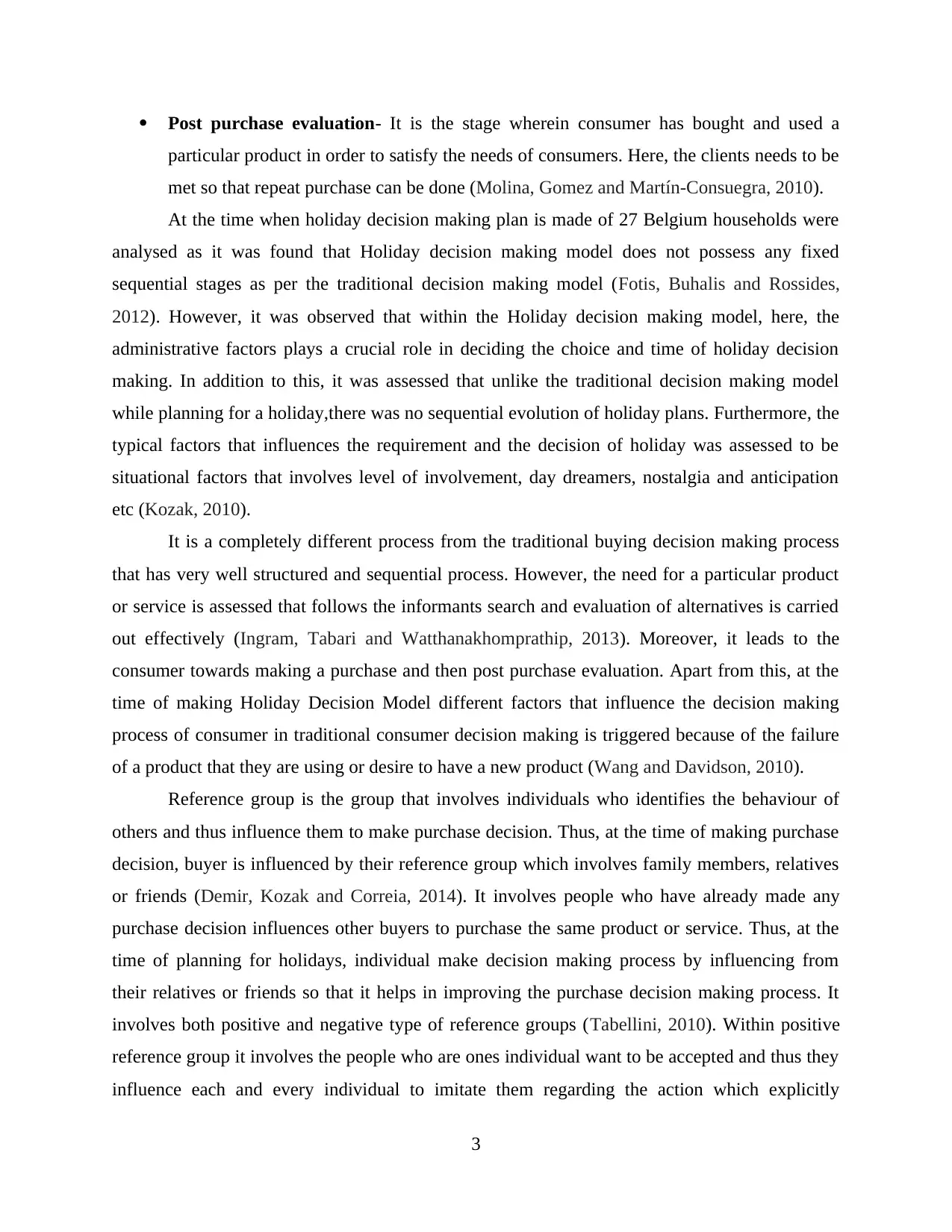
Post purchase evaluation- It is the stage wherein consumer has bought and used a
particular product in order to satisfy the needs of consumers. Here, the clients needs to be
met so that repeat purchase can be done (Molina, Gomez and Martín-Consuegra, 2010).
At the time when holiday decision making plan is made of 27 Belgium households were
analysed as it was found that Holiday decision making model does not possess any fixed
sequential stages as per the traditional decision making model (Fotis, Buhalis and Rossides,
2012). However, it was observed that within the Holiday decision making model, here, the
administrative factors plays a crucial role in deciding the choice and time of holiday decision
making. In addition to this, it was assessed that unlike the traditional decision making model
while planning for a holiday,there was no sequential evolution of holiday plans. Furthermore, the
typical factors that influences the requirement and the decision of holiday was assessed to be
situational factors that involves level of involvement, day dreamers, nostalgia and anticipation
etc (Kozak, 2010).
It is a completely different process from the traditional buying decision making process
that has very well structured and sequential process. However, the need for a particular product
or service is assessed that follows the informants search and evaluation of alternatives is carried
out effectively (Ingram, Tabari and Watthanakhomprathip, 2013). Moreover, it leads to the
consumer towards making a purchase and then post purchase evaluation. Apart from this, at the
time of making Holiday Decision Model different factors that influence the decision making
process of consumer in traditional consumer decision making is triggered because of the failure
of a product that they are using or desire to have a new product (Wang and Davidson, 2010).
Reference group is the group that involves individuals who identifies the behaviour of
others and thus influence them to make purchase decision. Thus, at the time of making purchase
decision, buyer is influenced by their reference group which involves family members, relatives
or friends (Demir, Kozak and Correia, 2014). It involves people who have already made any
purchase decision influences other buyers to purchase the same product or service. Thus, at the
time of planning for holidays, individual make decision making process by influencing from
their relatives or friends so that it helps in improving the purchase decision making process. It
involves both positive and negative type of reference groups (Tabellini, 2010). Within positive
reference group it involves the people who are ones individual want to be accepted and thus they
influence each and every individual to imitate them regarding the action which explicitly
3
particular product in order to satisfy the needs of consumers. Here, the clients needs to be
met so that repeat purchase can be done (Molina, Gomez and Martín-Consuegra, 2010).
At the time when holiday decision making plan is made of 27 Belgium households were
analysed as it was found that Holiday decision making model does not possess any fixed
sequential stages as per the traditional decision making model (Fotis, Buhalis and Rossides,
2012). However, it was observed that within the Holiday decision making model, here, the
administrative factors plays a crucial role in deciding the choice and time of holiday decision
making. In addition to this, it was assessed that unlike the traditional decision making model
while planning for a holiday,there was no sequential evolution of holiday plans. Furthermore, the
typical factors that influences the requirement and the decision of holiday was assessed to be
situational factors that involves level of involvement, day dreamers, nostalgia and anticipation
etc (Kozak, 2010).
It is a completely different process from the traditional buying decision making process
that has very well structured and sequential process. However, the need for a particular product
or service is assessed that follows the informants search and evaluation of alternatives is carried
out effectively (Ingram, Tabari and Watthanakhomprathip, 2013). Moreover, it leads to the
consumer towards making a purchase and then post purchase evaluation. Apart from this, at the
time of making Holiday Decision Model different factors that influence the decision making
process of consumer in traditional consumer decision making is triggered because of the failure
of a product that they are using or desire to have a new product (Wang and Davidson, 2010).
Reference group is the group that involves individuals who identifies the behaviour of
others and thus influence them to make purchase decision. Thus, at the time of making purchase
decision, buyer is influenced by their reference group which involves family members, relatives
or friends (Demir, Kozak and Correia, 2014). It involves people who have already made any
purchase decision influences other buyers to purchase the same product or service. Thus, at the
time of planning for holidays, individual make decision making process by influencing from
their relatives or friends so that it helps in improving the purchase decision making process. It
involves both positive and negative type of reference groups (Tabellini, 2010). Within positive
reference group it involves the people who are ones individual want to be accepted and thus they
influence each and every individual to imitate them regarding the action which explicitly
3
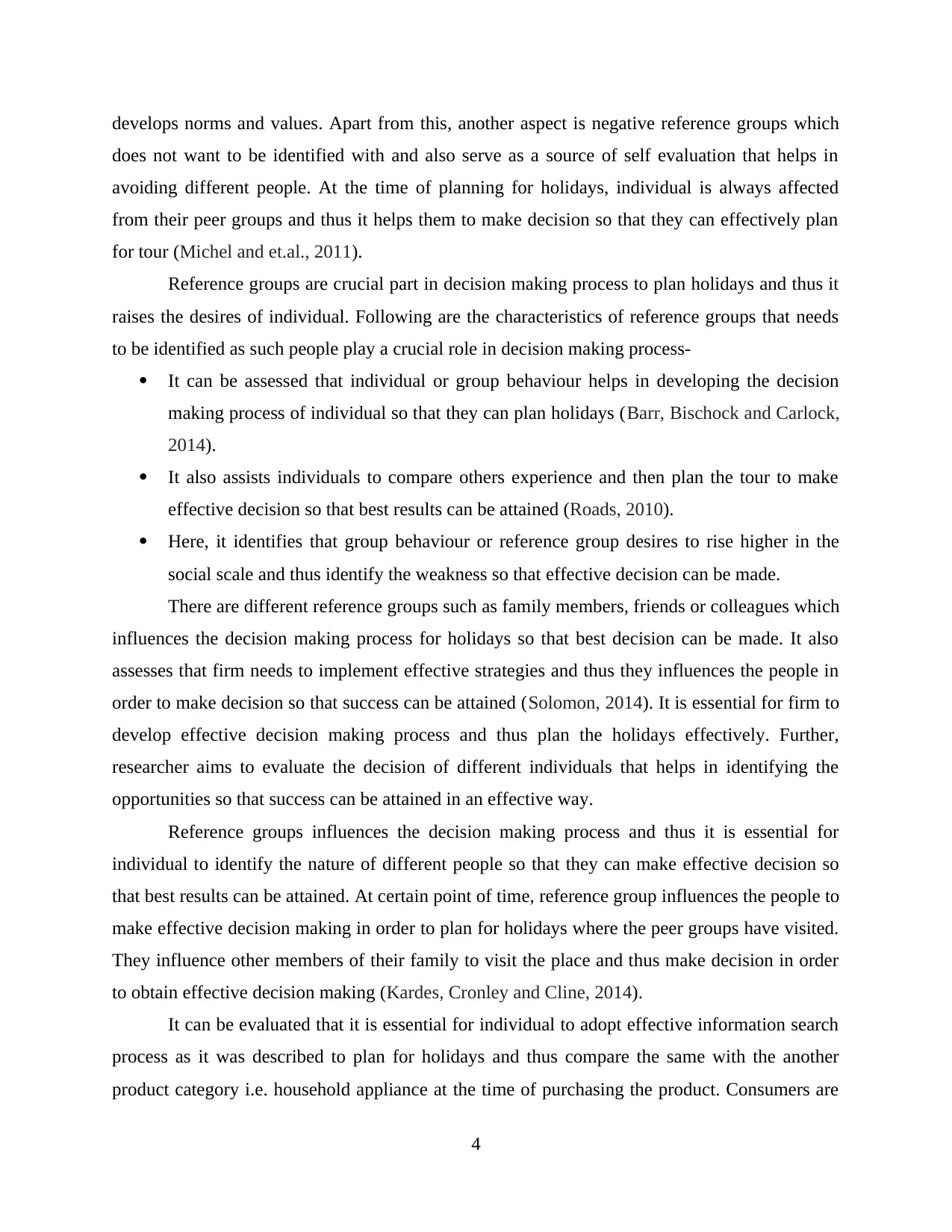
develops norms and values. Apart from this, another aspect is negative reference groups which
does not want to be identified with and also serve as a source of self evaluation that helps in
avoiding different people. At the time of planning for holidays, individual is always affected
from their peer groups and thus it helps them to make decision so that they can effectively plan
for tour (Michel and et.al., 2011).
Reference groups are crucial part in decision making process to plan holidays and thus it
raises the desires of individual. Following are the characteristics of reference groups that needs
to be identified as such people play a crucial role in decision making process-
It can be assessed that individual or group behaviour helps in developing the decision
making process of individual so that they can plan holidays (Barr, Bischock and Carlock,
2014).
It also assists individuals to compare others experience and then plan the tour to make
effective decision so that best results can be attained (Roads, 2010).
Here, it identifies that group behaviour or reference group desires to rise higher in the
social scale and thus identify the weakness so that effective decision can be made.
There are different reference groups such as family members, friends or colleagues which
influences the decision making process for holidays so that best decision can be made. It also
assesses that firm needs to implement effective strategies and thus they influences the people in
order to make decision so that success can be attained (Solomon, 2014). It is essential for firm to
develop effective decision making process and thus plan the holidays effectively. Further,
researcher aims to evaluate the decision of different individuals that helps in identifying the
opportunities so that success can be attained in an effective way.
Reference groups influences the decision making process and thus it is essential for
individual to identify the nature of different people so that they can make effective decision so
that best results can be attained. At certain point of time, reference group influences the people to
make effective decision making in order to plan for holidays where the peer groups have visited.
They influence other members of their family to visit the place and thus make decision in order
to obtain effective decision making (Kardes, Cronley and Cline, 2014).
It can be evaluated that it is essential for individual to adopt effective information search
process as it was described to plan for holidays and thus compare the same with the another
product category i.e. household appliance at the time of purchasing the product. Consumers are
4
does not want to be identified with and also serve as a source of self evaluation that helps in
avoiding different people. At the time of planning for holidays, individual is always affected
from their peer groups and thus it helps them to make decision so that they can effectively plan
for tour (Michel and et.al., 2011).
Reference groups are crucial part in decision making process to plan holidays and thus it
raises the desires of individual. Following are the characteristics of reference groups that needs
to be identified as such people play a crucial role in decision making process-
It can be assessed that individual or group behaviour helps in developing the decision
making process of individual so that they can plan holidays (Barr, Bischock and Carlock,
2014).
It also assists individuals to compare others experience and then plan the tour to make
effective decision so that best results can be attained (Roads, 2010).
Here, it identifies that group behaviour or reference group desires to rise higher in the
social scale and thus identify the weakness so that effective decision can be made.
There are different reference groups such as family members, friends or colleagues which
influences the decision making process for holidays so that best decision can be made. It also
assesses that firm needs to implement effective strategies and thus they influences the people in
order to make decision so that success can be attained (Solomon, 2014). It is essential for firm to
develop effective decision making process and thus plan the holidays effectively. Further,
researcher aims to evaluate the decision of different individuals that helps in identifying the
opportunities so that success can be attained in an effective way.
Reference groups influences the decision making process and thus it is essential for
individual to identify the nature of different people so that they can make effective decision so
that best results can be attained. At certain point of time, reference group influences the people to
make effective decision making in order to plan for holidays where the peer groups have visited.
They influence other members of their family to visit the place and thus make decision in order
to obtain effective decision making (Kardes, Cronley and Cline, 2014).
It can be evaluated that it is essential for individual to adopt effective information search
process as it was described to plan for holidays and thus compare the same with the another
product category i.e. household appliance at the time of purchasing the product. Consumers are
4
⊘ This is a preview!⊘
Do you want full access?
Subscribe today to unlock all pages.

Trusted by 1+ million students worldwide
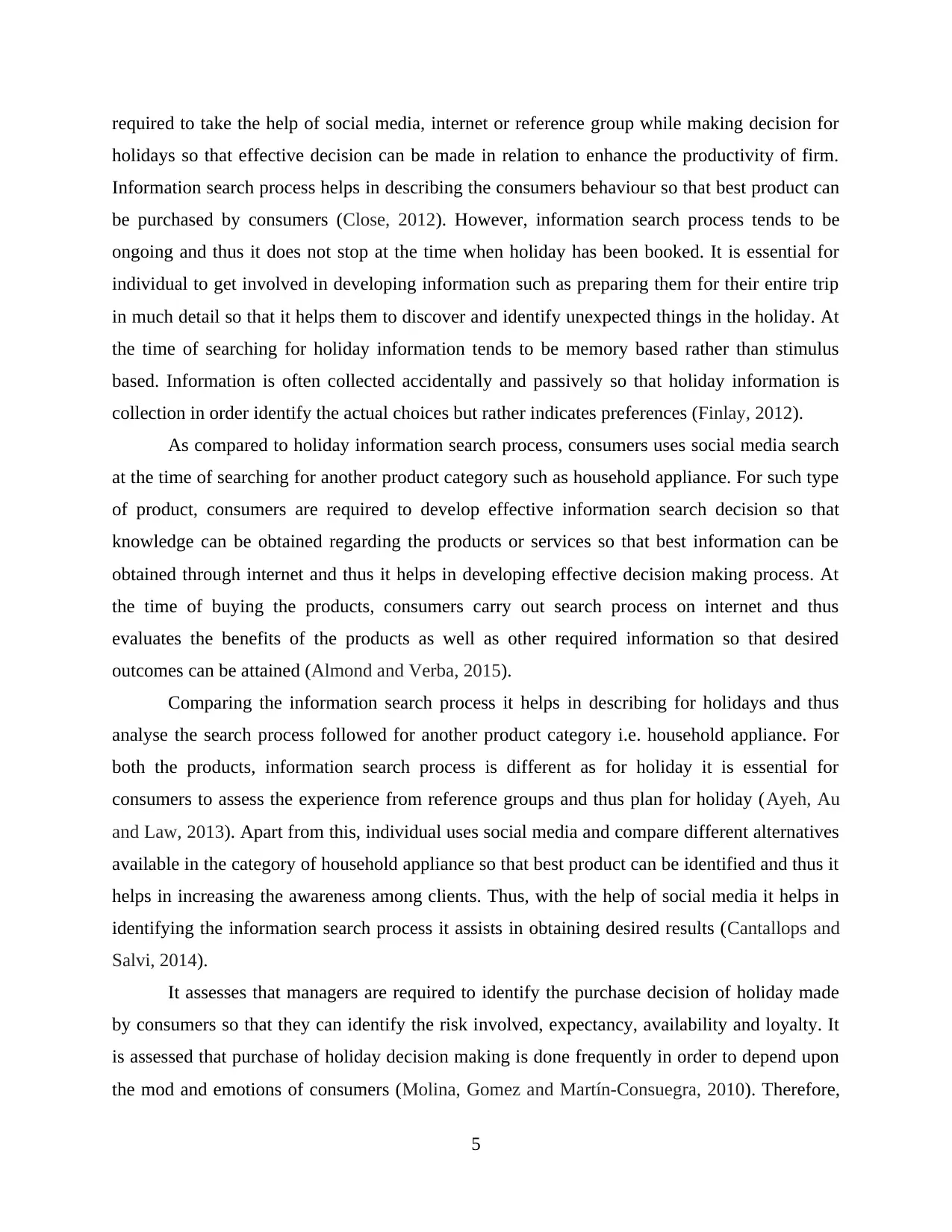
required to take the help of social media, internet or reference group while making decision for
holidays so that effective decision can be made in relation to enhance the productivity of firm.
Information search process helps in describing the consumers behaviour so that best product can
be purchased by consumers (Close, 2012). However, information search process tends to be
ongoing and thus it does not stop at the time when holiday has been booked. It is essential for
individual to get involved in developing information such as preparing them for their entire trip
in much detail so that it helps them to discover and identify unexpected things in the holiday. At
the time of searching for holiday information tends to be memory based rather than stimulus
based. Information is often collected accidentally and passively so that holiday information is
collection in order identify the actual choices but rather indicates preferences (Finlay, 2012).
As compared to holiday information search process, consumers uses social media search
at the time of searching for another product category such as household appliance. For such type
of product, consumers are required to develop effective information search decision so that
knowledge can be obtained regarding the products or services so that best information can be
obtained through internet and thus it helps in developing effective decision making process. At
the time of buying the products, consumers carry out search process on internet and thus
evaluates the benefits of the products as well as other required information so that desired
outcomes can be attained (Almond and Verba, 2015).
Comparing the information search process it helps in describing for holidays and thus
analyse the search process followed for another product category i.e. household appliance. For
both the products, information search process is different as for holiday it is essential for
consumers to assess the experience from reference groups and thus plan for holiday (Ayeh, Au
and Law, 2013). Apart from this, individual uses social media and compare different alternatives
available in the category of household appliance so that best product can be identified and thus it
helps in increasing the awareness among clients. Thus, with the help of social media it helps in
identifying the information search process it assists in obtaining desired results (Cantallops and
Salvi, 2014).
It assesses that managers are required to identify the purchase decision of holiday made
by consumers so that they can identify the risk involved, expectancy, availability and loyalty. It
is assessed that purchase of holiday decision making is done frequently in order to depend upon
the mod and emotions of consumers (Molina, Gomez and Martín-Consuegra, 2010). Therefore,
5
holidays so that effective decision can be made in relation to enhance the productivity of firm.
Information search process helps in describing the consumers behaviour so that best product can
be purchased by consumers (Close, 2012). However, information search process tends to be
ongoing and thus it does not stop at the time when holiday has been booked. It is essential for
individual to get involved in developing information such as preparing them for their entire trip
in much detail so that it helps them to discover and identify unexpected things in the holiday. At
the time of searching for holiday information tends to be memory based rather than stimulus
based. Information is often collected accidentally and passively so that holiday information is
collection in order identify the actual choices but rather indicates preferences (Finlay, 2012).
As compared to holiday information search process, consumers uses social media search
at the time of searching for another product category such as household appliance. For such type
of product, consumers are required to develop effective information search decision so that
knowledge can be obtained regarding the products or services so that best information can be
obtained through internet and thus it helps in developing effective decision making process. At
the time of buying the products, consumers carry out search process on internet and thus
evaluates the benefits of the products as well as other required information so that desired
outcomes can be attained (Almond and Verba, 2015).
Comparing the information search process it helps in describing for holidays and thus
analyse the search process followed for another product category i.e. household appliance. For
both the products, information search process is different as for holiday it is essential for
consumers to assess the experience from reference groups and thus plan for holiday (Ayeh, Au
and Law, 2013). Apart from this, individual uses social media and compare different alternatives
available in the category of household appliance so that best product can be identified and thus it
helps in increasing the awareness among clients. Thus, with the help of social media it helps in
identifying the information search process it assists in obtaining desired results (Cantallops and
Salvi, 2014).
It assesses that managers are required to identify the purchase decision of holiday made
by consumers so that they can identify the risk involved, expectancy, availability and loyalty. It
is assessed that purchase of holiday decision making is done frequently in order to depend upon
the mod and emotions of consumers (Molina, Gomez and Martín-Consuegra, 2010). Therefore,
5
Paraphrase This Document
Need a fresh take? Get an instant paraphrase of this document with our AI Paraphraser
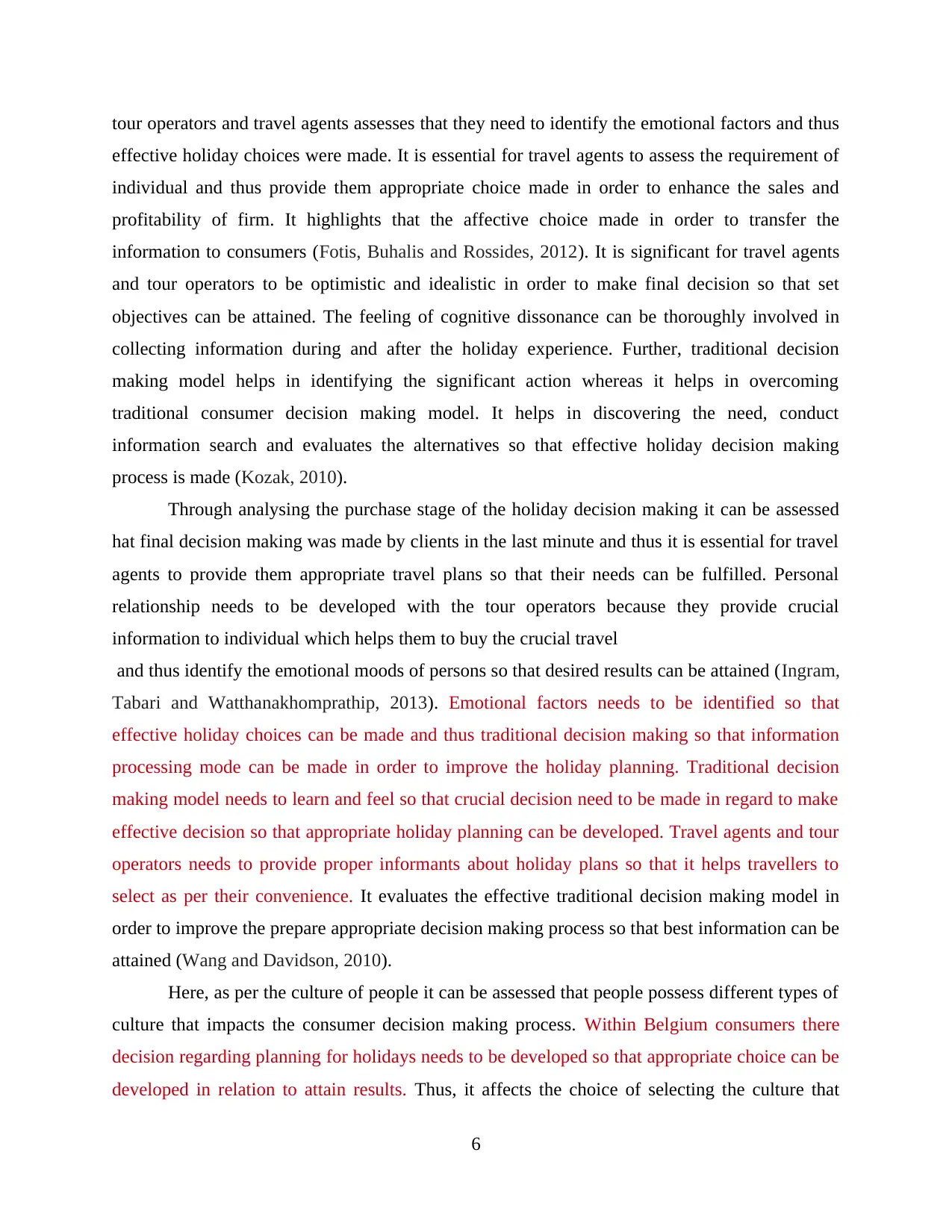
tour operators and travel agents assesses that they need to identify the emotional factors and thus
effective holiday choices were made. It is essential for travel agents to assess the requirement of
individual and thus provide them appropriate choice made in order to enhance the sales and
profitability of firm. It highlights that the affective choice made in order to transfer the
information to consumers (Fotis, Buhalis and Rossides, 2012). It is significant for travel agents
and tour operators to be optimistic and idealistic in order to make final decision so that set
objectives can be attained. The feeling of cognitive dissonance can be thoroughly involved in
collecting information during and after the holiday experience. Further, traditional decision
making model helps in identifying the significant action whereas it helps in overcoming
traditional consumer decision making model. It helps in discovering the need, conduct
information search and evaluates the alternatives so that effective holiday decision making
process is made (Kozak, 2010).
Through analysing the purchase stage of the holiday decision making it can be assessed
hat final decision making was made by clients in the last minute and thus it is essential for travel
agents to provide them appropriate travel plans so that their needs can be fulfilled. Personal
relationship needs to be developed with the tour operators because they provide crucial
information to individual which helps them to buy the crucial travel
and thus identify the emotional moods of persons so that desired results can be attained (Ingram,
Tabari and Watthanakhomprathip, 2013). Emotional factors needs to be identified so that
effective holiday choices can be made and thus traditional decision making so that information
processing mode can be made in order to improve the holiday planning. Traditional decision
making model needs to learn and feel so that crucial decision need to be made in regard to make
effective decision so that appropriate holiday planning can be developed. Travel agents and tour
operators needs to provide proper informants about holiday plans so that it helps travellers to
select as per their convenience. It evaluates the effective traditional decision making model in
order to improve the prepare appropriate decision making process so that best information can be
attained (Wang and Davidson, 2010).
Here, as per the culture of people it can be assessed that people possess different types of
culture that impacts the consumer decision making process. Within Belgium consumers there
decision regarding planning for holidays needs to be developed so that appropriate choice can be
developed in relation to attain results. Thus, it affects the choice of selecting the culture that
6
effective holiday choices were made. It is essential for travel agents to assess the requirement of
individual and thus provide them appropriate choice made in order to enhance the sales and
profitability of firm. It highlights that the affective choice made in order to transfer the
information to consumers (Fotis, Buhalis and Rossides, 2012). It is significant for travel agents
and tour operators to be optimistic and idealistic in order to make final decision so that set
objectives can be attained. The feeling of cognitive dissonance can be thoroughly involved in
collecting information during and after the holiday experience. Further, traditional decision
making model helps in identifying the significant action whereas it helps in overcoming
traditional consumer decision making model. It helps in discovering the need, conduct
information search and evaluates the alternatives so that effective holiday decision making
process is made (Kozak, 2010).
Through analysing the purchase stage of the holiday decision making it can be assessed
hat final decision making was made by clients in the last minute and thus it is essential for travel
agents to provide them appropriate travel plans so that their needs can be fulfilled. Personal
relationship needs to be developed with the tour operators because they provide crucial
information to individual which helps them to buy the crucial travel
and thus identify the emotional moods of persons so that desired results can be attained (Ingram,
Tabari and Watthanakhomprathip, 2013). Emotional factors needs to be identified so that
effective holiday choices can be made and thus traditional decision making so that information
processing mode can be made in order to improve the holiday planning. Traditional decision
making model needs to learn and feel so that crucial decision need to be made in regard to make
effective decision so that appropriate holiday planning can be developed. Travel agents and tour
operators needs to provide proper informants about holiday plans so that it helps travellers to
select as per their convenience. It evaluates the effective traditional decision making model in
order to improve the prepare appropriate decision making process so that best information can be
attained (Wang and Davidson, 2010).
Here, as per the culture of people it can be assessed that people possess different types of
culture that impacts the consumer decision making process. Within Belgium consumers there
decision regarding planning for holidays needs to be developed so that appropriate choice can be
developed in relation to attain results. Thus, it affects the choice of selecting the culture that
6
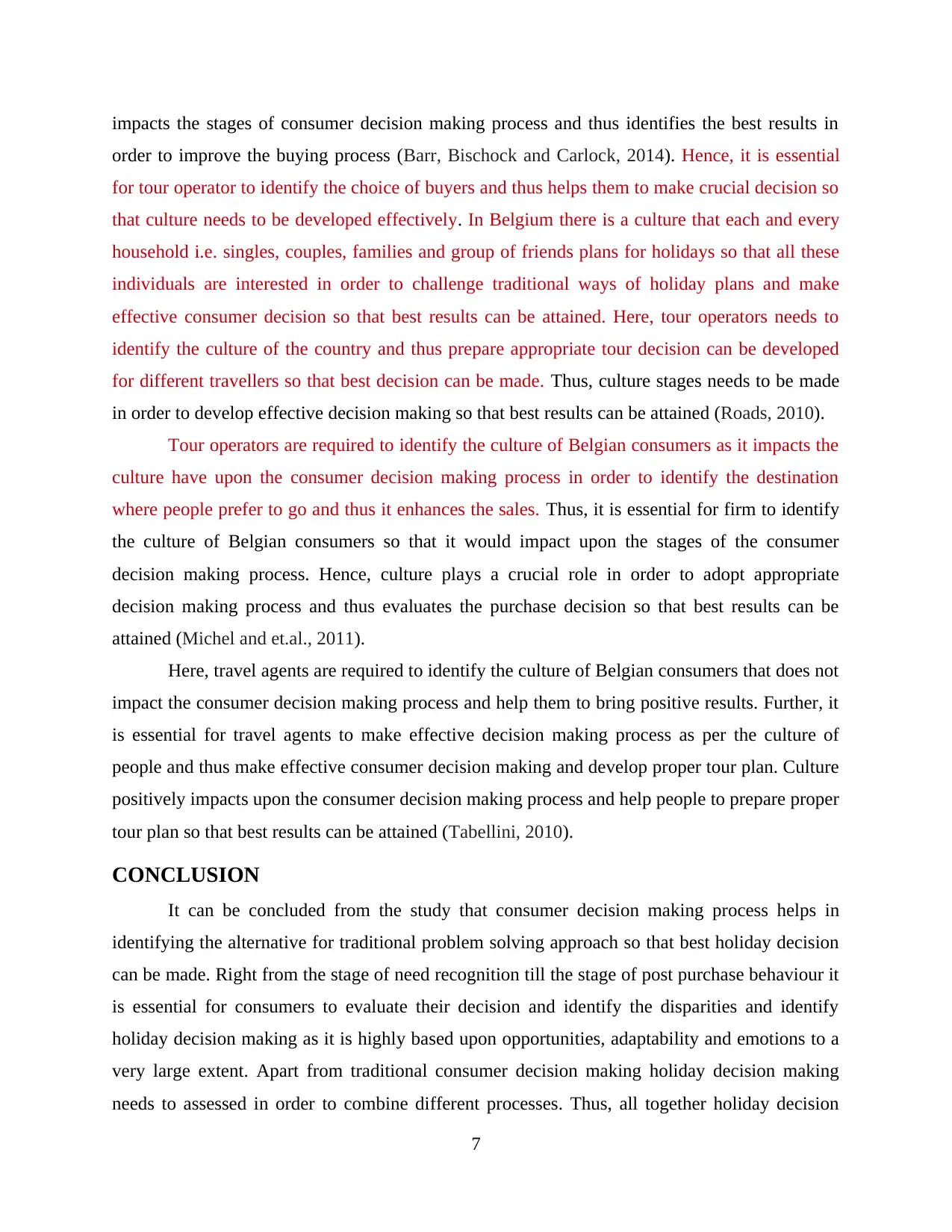
impacts the stages of consumer decision making process and thus identifies the best results in
order to improve the buying process (Barr, Bischock and Carlock, 2014). Hence, it is essential
for tour operator to identify the choice of buyers and thus helps them to make crucial decision so
that culture needs to be developed effectively. In Belgium there is a culture that each and every
household i.e. singles, couples, families and group of friends plans for holidays so that all these
individuals are interested in order to challenge traditional ways of holiday plans and make
effective consumer decision so that best results can be attained. Here, tour operators needs to
identify the culture of the country and thus prepare appropriate tour decision can be developed
for different travellers so that best decision can be made. Thus, culture stages needs to be made
in order to develop effective decision making so that best results can be attained (Roads, 2010).
Tour operators are required to identify the culture of Belgian consumers as it impacts the
culture have upon the consumer decision making process in order to identify the destination
where people prefer to go and thus it enhances the sales. Thus, it is essential for firm to identify
the culture of Belgian consumers so that it would impact upon the stages of the consumer
decision making process. Hence, culture plays a crucial role in order to adopt appropriate
decision making process and thus evaluates the purchase decision so that best results can be
attained (Michel and et.al., 2011).
Here, travel agents are required to identify the culture of Belgian consumers that does not
impact the consumer decision making process and help them to bring positive results. Further, it
is essential for travel agents to make effective decision making process as per the culture of
people and thus make effective consumer decision making and develop proper tour plan. Culture
positively impacts upon the consumer decision making process and help people to prepare proper
tour plan so that best results can be attained (Tabellini, 2010).
CONCLUSION
It can be concluded from the study that consumer decision making process helps in
identifying the alternative for traditional problem solving approach so that best holiday decision
can be made. Right from the stage of need recognition till the stage of post purchase behaviour it
is essential for consumers to evaluate their decision and identify the disparities and identify
holiday decision making as it is highly based upon opportunities, adaptability and emotions to a
very large extent. Apart from traditional consumer decision making holiday decision making
needs to assessed in order to combine different processes. Thus, all together holiday decision
7
order to improve the buying process (Barr, Bischock and Carlock, 2014). Hence, it is essential
for tour operator to identify the choice of buyers and thus helps them to make crucial decision so
that culture needs to be developed effectively. In Belgium there is a culture that each and every
household i.e. singles, couples, families and group of friends plans for holidays so that all these
individuals are interested in order to challenge traditional ways of holiday plans and make
effective consumer decision so that best results can be attained. Here, tour operators needs to
identify the culture of the country and thus prepare appropriate tour decision can be developed
for different travellers so that best decision can be made. Thus, culture stages needs to be made
in order to develop effective decision making so that best results can be attained (Roads, 2010).
Tour operators are required to identify the culture of Belgian consumers as it impacts the
culture have upon the consumer decision making process in order to identify the destination
where people prefer to go and thus it enhances the sales. Thus, it is essential for firm to identify
the culture of Belgian consumers so that it would impact upon the stages of the consumer
decision making process. Hence, culture plays a crucial role in order to adopt appropriate
decision making process and thus evaluates the purchase decision so that best results can be
attained (Michel and et.al., 2011).
Here, travel agents are required to identify the culture of Belgian consumers that does not
impact the consumer decision making process and help them to bring positive results. Further, it
is essential for travel agents to make effective decision making process as per the culture of
people and thus make effective consumer decision making and develop proper tour plan. Culture
positively impacts upon the consumer decision making process and help people to prepare proper
tour plan so that best results can be attained (Tabellini, 2010).
CONCLUSION
It can be concluded from the study that consumer decision making process helps in
identifying the alternative for traditional problem solving approach so that best holiday decision
can be made. Right from the stage of need recognition till the stage of post purchase behaviour it
is essential for consumers to evaluate their decision and identify the disparities and identify
holiday decision making as it is highly based upon opportunities, adaptability and emotions to a
very large extent. Apart from traditional consumer decision making holiday decision making
needs to assessed in order to combine different processes. Thus, all together holiday decision
7
⊘ This is a preview!⊘
Do you want full access?
Subscribe today to unlock all pages.

Trusted by 1+ million students worldwide
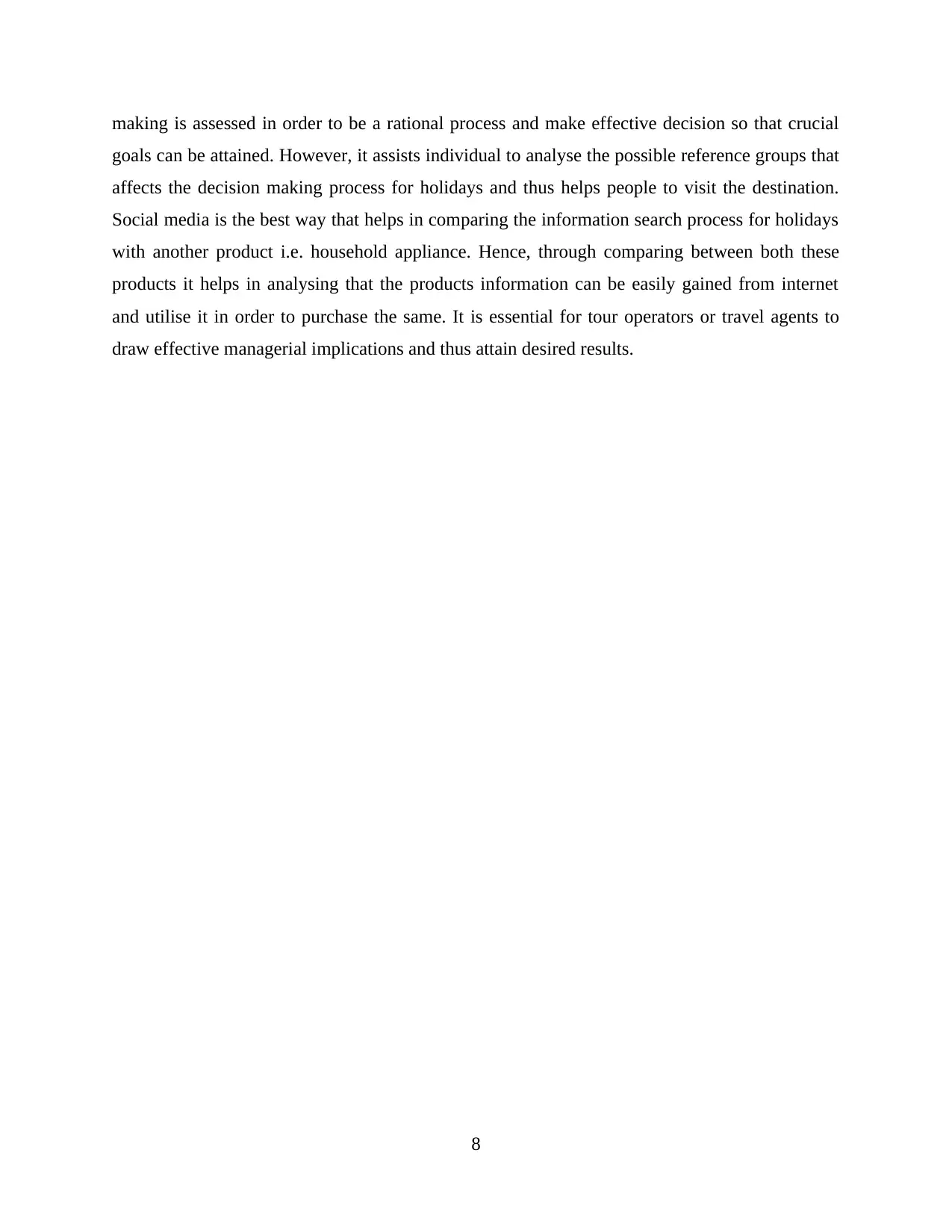
making is assessed in order to be a rational process and make effective decision so that crucial
goals can be attained. However, it assists individual to analyse the possible reference groups that
affects the decision making process for holidays and thus helps people to visit the destination.
Social media is the best way that helps in comparing the information search process for holidays
with another product i.e. household appliance. Hence, through comparing between both these
products it helps in analysing that the products information can be easily gained from internet
and utilise it in order to purchase the same. It is essential for tour operators or travel agents to
draw effective managerial implications and thus attain desired results.
8
goals can be attained. However, it assists individual to analyse the possible reference groups that
affects the decision making process for holidays and thus helps people to visit the destination.
Social media is the best way that helps in comparing the information search process for holidays
with another product i.e. household appliance. Hence, through comparing between both these
products it helps in analysing that the products information can be easily gained from internet
and utilise it in order to purchase the same. It is essential for tour operators or travel agents to
draw effective managerial implications and thus attain desired results.
8
Paraphrase This Document
Need a fresh take? Get an instant paraphrase of this document with our AI Paraphraser
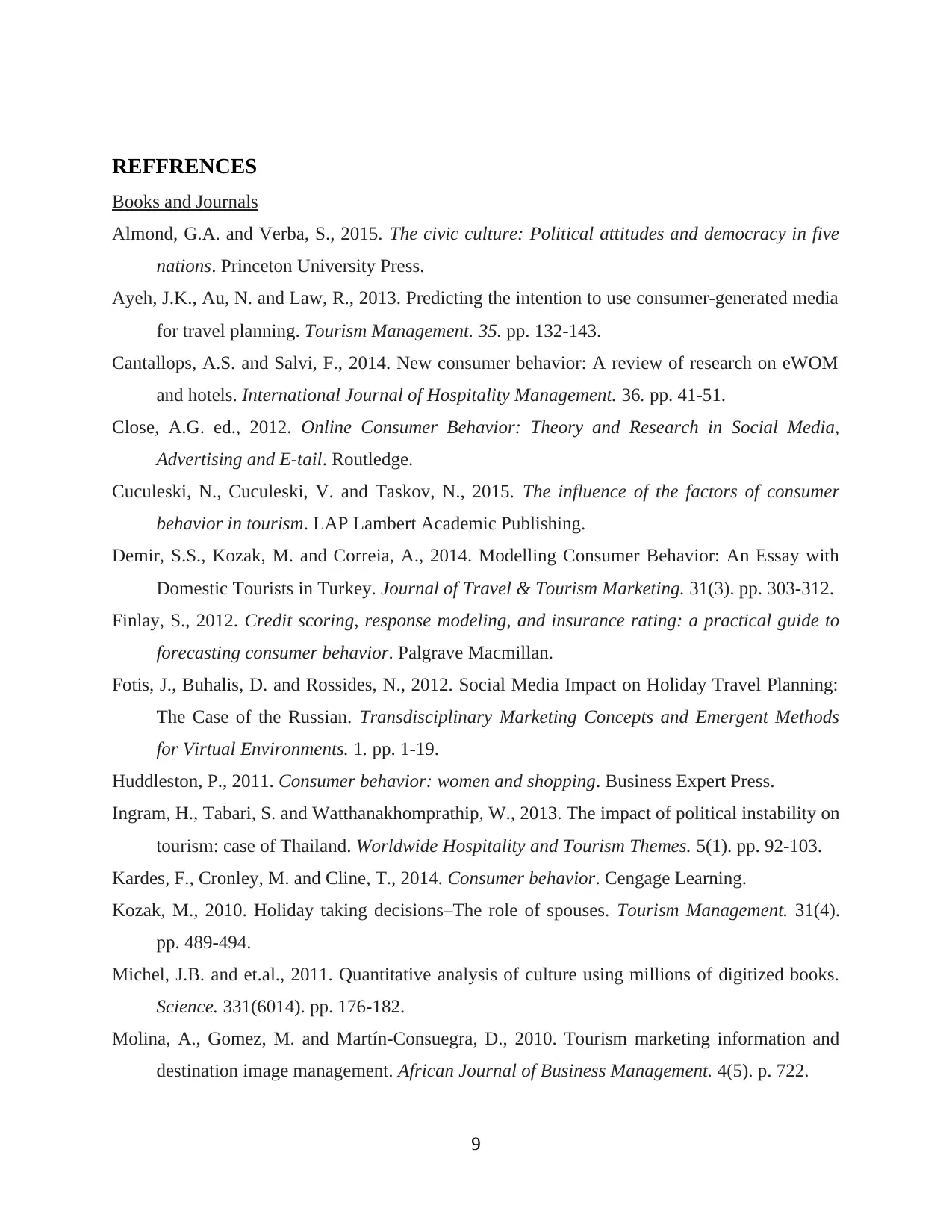
REFFRENCES
Books and Journals
Almond, G.A. and Verba, S., 2015. The civic culture: Political attitudes and democracy in five
nations. Princeton University Press.
Ayeh, J.K., Au, N. and Law, R., 2013. Predicting the intention to use consumer-generated media
for travel planning. Tourism Management. 35. pp. 132-143.
Cantallops, A.S. and Salvi, F., 2014. New consumer behavior: A review of research on eWOM
and hotels. International Journal of Hospitality Management. 36. pp. 41-51.
Close, A.G. ed., 2012. Online Consumer Behavior: Theory and Research in Social Media,
Advertising and E-tail. Routledge.
Cuculeski, N., Cuculeski, V. and Taskov, N., 2015. The influence of the factors of consumer
behavior in tourism. LAP Lambert Academic Publishing.
Demir, S.S., Kozak, M. and Correia, A., 2014. Modelling Consumer Behavior: An Essay with
Domestic Tourists in Turkey. Journal of Travel & Tourism Marketing. 31(3). pp. 303-312.
Finlay, S., 2012. Credit scoring, response modeling, and insurance rating: a practical guide to
forecasting consumer behavior. Palgrave Macmillan.
Fotis, J., Buhalis, D. and Rossides, N., 2012. Social Media Impact on Holiday Travel Planning:
The Case of the Russian. Transdisciplinary Marketing Concepts and Emergent Methods
for Virtual Environments. 1. pp. 1-19.
Huddleston, P., 2011. Consumer behavior: women and shopping. Business Expert Press.
Ingram, H., Tabari, S. and Watthanakhomprathip, W., 2013. The impact of political instability on
tourism: case of Thailand. Worldwide Hospitality and Tourism Themes. 5(1). pp. 92-103.
Kardes, F., Cronley, M. and Cline, T., 2014. Consumer behavior. Cengage Learning.
Kozak, M., 2010. Holiday taking decisions–The role of spouses. Tourism Management. 31(4).
pp. 489-494.
Michel, J.B. and et.al., 2011. Quantitative analysis of culture using millions of digitized books.
Science. 331(6014). pp. 176-182.
Molina, A., Gomez, M. and Martín-Consuegra, D., 2010. Tourism marketing information and
destination image management. African Journal of Business Management. 4(5). p. 722.
9
Books and Journals
Almond, G.A. and Verba, S., 2015. The civic culture: Political attitudes and democracy in five
nations. Princeton University Press.
Ayeh, J.K., Au, N. and Law, R., 2013. Predicting the intention to use consumer-generated media
for travel planning. Tourism Management. 35. pp. 132-143.
Cantallops, A.S. and Salvi, F., 2014. New consumer behavior: A review of research on eWOM
and hotels. International Journal of Hospitality Management. 36. pp. 41-51.
Close, A.G. ed., 2012. Online Consumer Behavior: Theory and Research in Social Media,
Advertising and E-tail. Routledge.
Cuculeski, N., Cuculeski, V. and Taskov, N., 2015. The influence of the factors of consumer
behavior in tourism. LAP Lambert Academic Publishing.
Demir, S.S., Kozak, M. and Correia, A., 2014. Modelling Consumer Behavior: An Essay with
Domestic Tourists in Turkey. Journal of Travel & Tourism Marketing. 31(3). pp. 303-312.
Finlay, S., 2012. Credit scoring, response modeling, and insurance rating: a practical guide to
forecasting consumer behavior. Palgrave Macmillan.
Fotis, J., Buhalis, D. and Rossides, N., 2012. Social Media Impact on Holiday Travel Planning:
The Case of the Russian. Transdisciplinary Marketing Concepts and Emergent Methods
for Virtual Environments. 1. pp. 1-19.
Huddleston, P., 2011. Consumer behavior: women and shopping. Business Expert Press.
Ingram, H., Tabari, S. and Watthanakhomprathip, W., 2013. The impact of political instability on
tourism: case of Thailand. Worldwide Hospitality and Tourism Themes. 5(1). pp. 92-103.
Kardes, F., Cronley, M. and Cline, T., 2014. Consumer behavior. Cengage Learning.
Kozak, M., 2010. Holiday taking decisions–The role of spouses. Tourism Management. 31(4).
pp. 489-494.
Michel, J.B. and et.al., 2011. Quantitative analysis of culture using millions of digitized books.
Science. 331(6014). pp. 176-182.
Molina, A., Gomez, M. and Martín-Consuegra, D., 2010. Tourism marketing information and
destination image management. African Journal of Business Management. 4(5). p. 722.
9
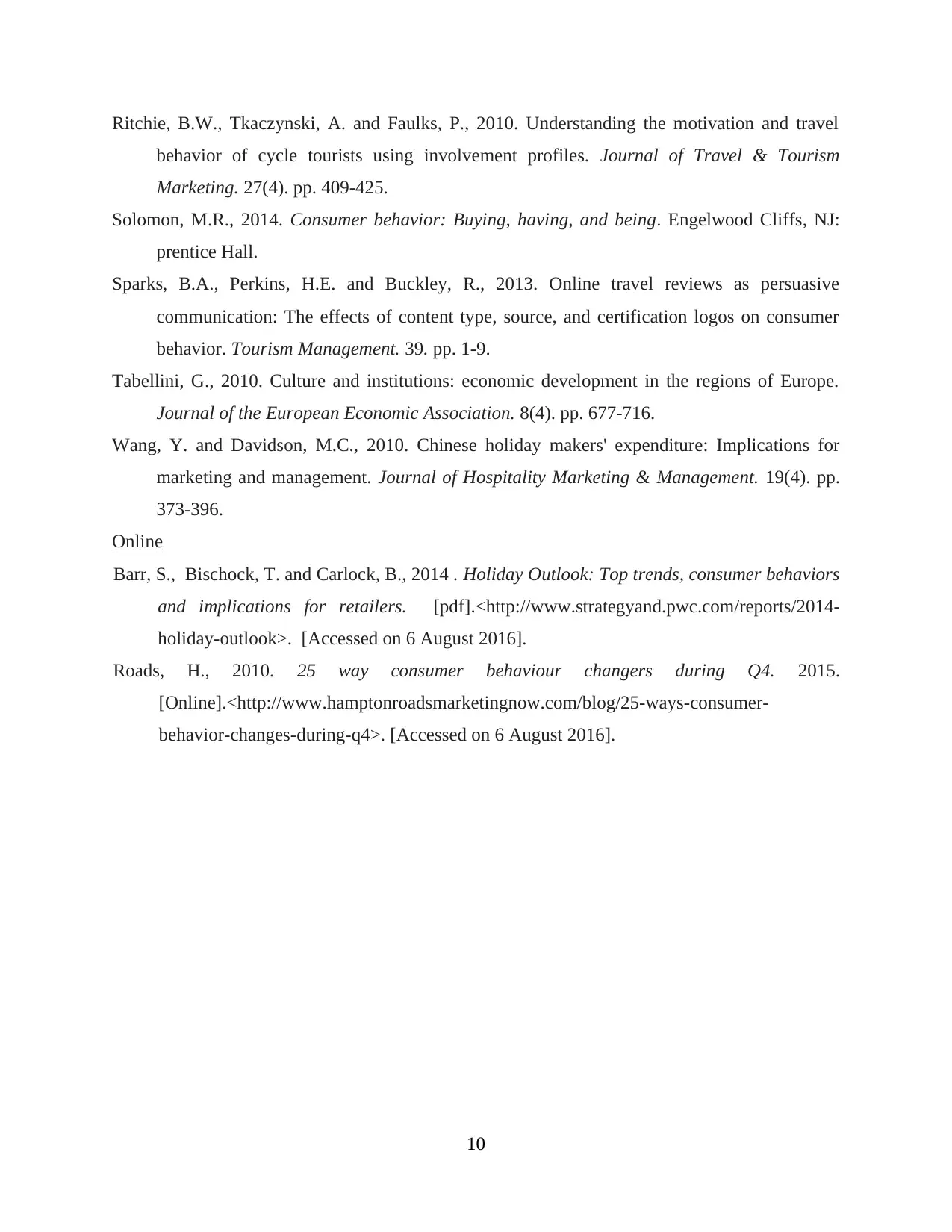
Ritchie, B.W., Tkaczynski, A. and Faulks, P., 2010. Understanding the motivation and travel
behavior of cycle tourists using involvement profiles. Journal of Travel & Tourism
Marketing. 27(4). pp. 409-425.
Solomon, M.R., 2014. Consumer behavior: Buying, having, and being. Engelwood Cliffs, NJ:
prentice Hall.
Sparks, B.A., Perkins, H.E. and Buckley, R., 2013. Online travel reviews as persuasive
communication: The effects of content type, source, and certification logos on consumer
behavior. Tourism Management. 39. pp. 1-9.
Tabellini, G., 2010. Culture and institutions: economic development in the regions of Europe.
Journal of the European Economic Association. 8(4). pp. 677-716.
Wang, Y. and Davidson, M.C., 2010. Chinese holiday makers' expenditure: Implications for
marketing and management. Journal of Hospitality Marketing & Management. 19(4). pp.
373-396.
Online
Barr, S., Bischock, T. and Carlock, B., 2014 . Holiday Outlook: Top trends, consumer behaviors
and implications for retailers. [pdf].<http://www.strategyand.pwc.com/reports/2014-
holiday-outlook>. [Accessed on 6 August 2016].
Roads, H., 2010. 25 way consumer behaviour changers during Q4. 2015.
[Online].<http://www.hamptonroadsmarketingnow.com/blog/25-ways-consumer-
behavior-changes-during-q4>. [Accessed on 6 August 2016].
10
behavior of cycle tourists using involvement profiles. Journal of Travel & Tourism
Marketing. 27(4). pp. 409-425.
Solomon, M.R., 2014. Consumer behavior: Buying, having, and being. Engelwood Cliffs, NJ:
prentice Hall.
Sparks, B.A., Perkins, H.E. and Buckley, R., 2013. Online travel reviews as persuasive
communication: The effects of content type, source, and certification logos on consumer
behavior. Tourism Management. 39. pp. 1-9.
Tabellini, G., 2010. Culture and institutions: economic development in the regions of Europe.
Journal of the European Economic Association. 8(4). pp. 677-716.
Wang, Y. and Davidson, M.C., 2010. Chinese holiday makers' expenditure: Implications for
marketing and management. Journal of Hospitality Marketing & Management. 19(4). pp.
373-396.
Online
Barr, S., Bischock, T. and Carlock, B., 2014 . Holiday Outlook: Top trends, consumer behaviors
and implications for retailers. [pdf].<http://www.strategyand.pwc.com/reports/2014-
holiday-outlook>. [Accessed on 6 August 2016].
Roads, H., 2010. 25 way consumer behaviour changers during Q4. 2015.
[Online].<http://www.hamptonroadsmarketingnow.com/blog/25-ways-consumer-
behavior-changes-during-q4>. [Accessed on 6 August 2016].
10
⊘ This is a preview!⊘
Do you want full access?
Subscribe today to unlock all pages.

Trusted by 1+ million students worldwide
1 out of 14
Related Documents
Your All-in-One AI-Powered Toolkit for Academic Success.
+13062052269
info@desklib.com
Available 24*7 on WhatsApp / Email
![[object Object]](/_next/static/media/star-bottom.7253800d.svg)
Unlock your academic potential
Copyright © 2020–2025 A2Z Services. All Rights Reserved. Developed and managed by ZUCOL.




